Small meteorite that fell between Prato and Pistoia, the research started

Prato, 3 October 2021 – A little one meteorite, weighing approximately between 30 and 100 grams, it fell in the night between 1 and 2 October between the provinces of Prato and Pistoia. The fireball was ‘sighted’ by eight cameras of the Prisma space network located in Tuscany and central Italy.
“After the preliminary analysis of the meteor, the experts of the Prisma network, coordinated by the National Institute of Astrophysics, determined that the meteor should have fallen into an area between the towns of Lucciano (Pistoia) and Oste (Prato) – explains in a note the director of the Parsec Foundation which includes the Museum of Planetary Sciences of Prato, Marco Morelli -. And that’s where we’ll look for it. The chances of finding such a small object in a short time are very low ».
Already from tomorrow field research will begin and on Tuesday there will be an operational meeting to organize the exploration on the ground through an app that will allow you to trace the areas already sieved. «I am sure that many amateurs will join the research, any help is precious – adds Morelli -. But anyone who finds a small stone with the characteristics of a meteorite, a stone covered with a dark patina and with rounded corners, must immediately notify us, perhaps by sending a photo. The commercial value of meteorites is very low compared to the scientific one ».
«Who found or thought they had found one – the experts explain in this regard – he must not touch it with his hands, but photograph it and contact the Museum of Planetary Sciences in Prato ». In January 2020 another meteorite reported by the Prisma network was found in the countryside of Carpi (Modena).
You are using an out of date browser. It may not display this or other websites correctly.
You should upgrade or use an alternative browser.
You should upgrade or use an alternative browser.
Near-Earth objects and close calls
- Thread starter Gawan
- Start date
Line-1
ROZADOR BOLID ON #CANARIAS THIS MORNING. This event #SPMN051021G overflew #LaPalma at 5h32m16s TU. It can be seen in this sequence of @GTCtelescope its persistent wake in the initial section which, due to its unusual geometry, lasted 10 seconds!Notified by
@StargazerLZT
Line-2
2) In fact, it was also registered by the Playa Blanca station, Yaiza in #Lanzarote by Ramón López @StargazerLZT . As explained by Prof.
@Josep_Trigo of the @iSpaceSci@IEEC_space : "It was originated by a low-lying cometary bolide that disintegrated producing a 10-minute wake"
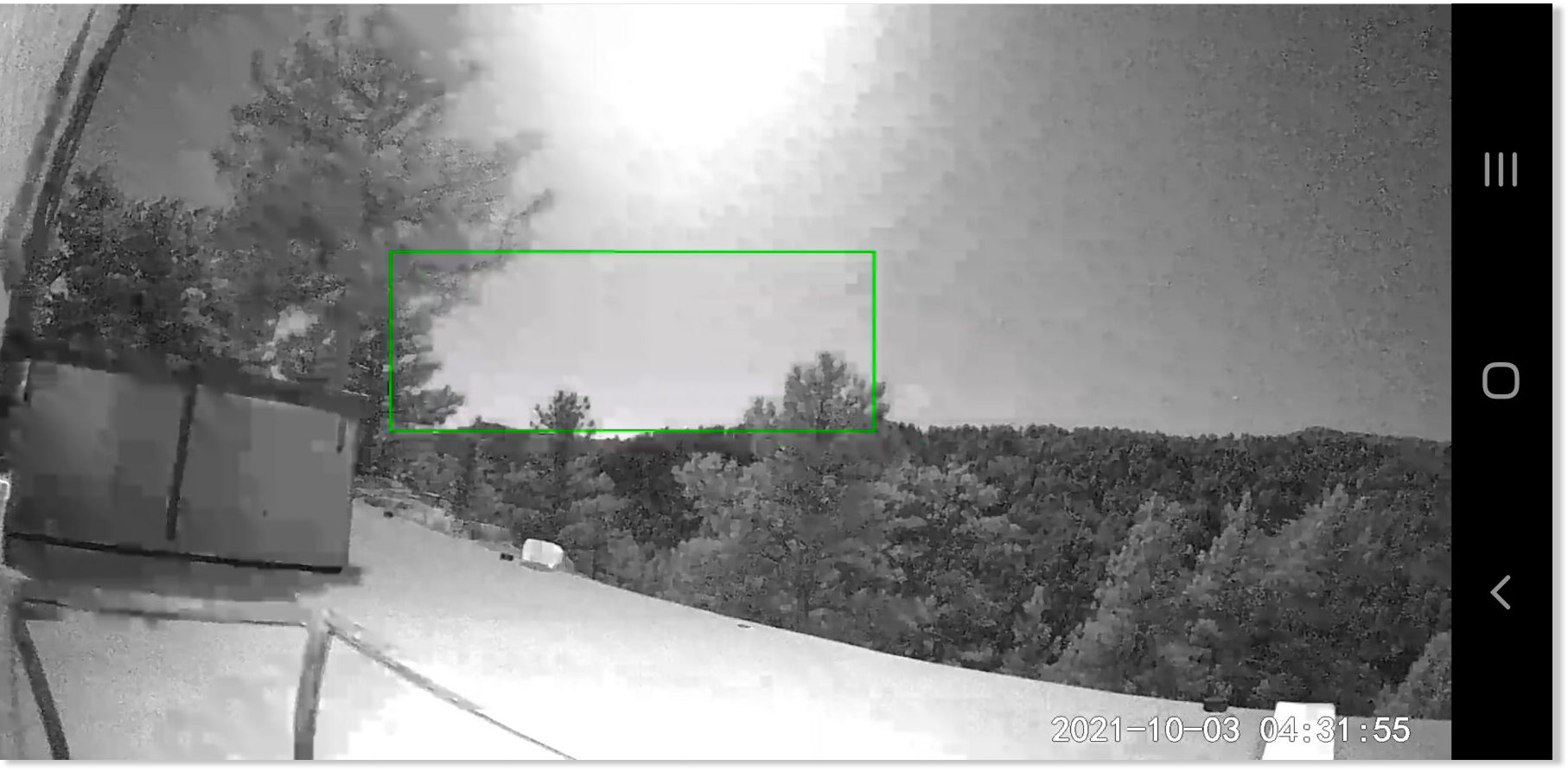
Meteor fireball turns night into day over Colorado, New Mexico and Wyoming
We received 50 reports about a fireball seen over CO, NM and WY on Sunday, October 3rd 2021 around 10:33 UT. For this event, we received 12 videos and 4 photos.
WE WILL FOLLOW FROM #CANARIAS THE POSSIBLE WEATHER BURST OF "ALTARIDAS" OVER THE NEXT NIGHT. The meteoroids that intercept the Earth's orbit are associated with comet 15P / Finlay and were produced in the comet's recent passage through perihelion.
Line-2
2) Its meteors have a radiant in the constellation of the Altar (Ara), specifically in Right Ascension: 257º and Declination -57.5º, low on the horizon. So much so that it will be almost impossible to see any from the Peninsula if it is not "grazing" Astrophotographers take aim at Scorpio!

 www.universetoday.com
Posted on October 5, 2021 by David Dickinson
www.universetoday.com
Posted on October 5, 2021 by David Dickinson
The new Arid meteor shower may be making itself known in early October 2021.
This morning, I saw a bright artificial satellite that blinks repeatedly. It looks like it was seen with a wide-angle camera from his home in Hiratsuka toward the high sky east at 4:58 on October 5, 2021. When I checked the orbit, it was a Starlink satellite (STARLINK-2402 / NORAD 47819). It is believed to be spinning violently and may be out of control.
Line-2
2) Its meteors have a radiant in the constellation of the Altar (Ara), specifically in Right Ascension: 257º and Declination -57.5º, low on the horizon. So much so that it will be almost impossible to see any from the Peninsula if it is not "grazing" Astrophotographers take aim at Scorpio!

Arid Meteor Outburst in the Works This Week?
A new Arid meteor shower may be making itself known in early October 2021.
The new Arid meteor shower may be making itself known in early October 2021.
It’s not every day that we witness an outburst from a new meteor shower gracing the skies of the Earth. But that’s just what may be in store this week for fortunate observers deep in the southern hemisphere, with the advent of the Arid meteors.
The shower in question should radiate from the otherwise obscure southern hemisphere constellation of Ara the Altar (perhaps, they should be known as the ‘Ara-tids?’ The radiant position is Right Ascension 17h 7’, Declination -57.5 degrees south.
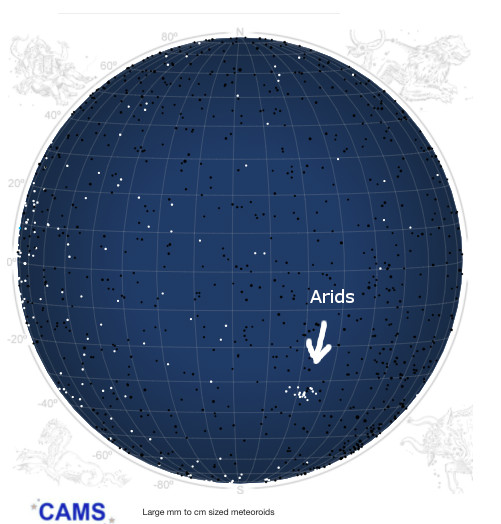
Arid meteor activity, in CAMS’ All-Sky view. Credit: SETI/NASA Ames/CAMS
The source of the shower is short period Comet 15P/Finlay. On a 6.5 year orbit, Comet 15P reached perihelion on July 13th this past summer, and its debris trail intersects the Earth’s orbit in early October.
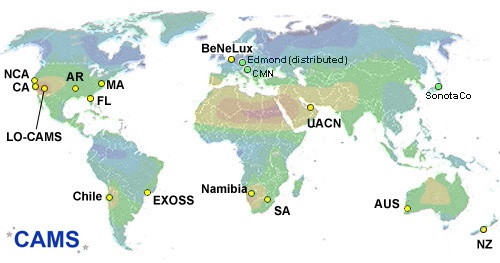
The worldwide CAMS meteor network. Credit: SETI/NASA Ames/CAMS.
Early observations of the Arids late last month were promising. Specifically, SETI Institute and NASA Ames Research Center astronomer Peter Jenniskens, and T. Cooper and D. Lauretta of the Astronomical Society of South Africa and the University of Arizona respectively found an uptick of 13 meteors seen in NASA Ames’ worldwide Cameras for All-Sky Meteor Surveillance (CAMS). These cameras were based in New Zealand and Chile, and caught the meteors hailing from the constellation Ara on the clear sky nights of 28-30 September. This is from debris ejected from Comet 15/P Finlay during its perihelion passage in 1995.
Two more, stronger outbursts are projected for the evening of October 6-7th (Wednesday night into Thursday morning). Luckily, the Moon reaches New phase on October 6th, putting it out of view. The first peak courtesy of the 2002 trail is expected to arrive on Oct 7th at 00:35 Universal Time (UT), with the second set for 3:55 UT. This favors the southern tip of South America, though observers across the southern hemisphere should be vigilant for any increase in meteor activity, especially from the direction of the constellation Ara near the region of the south celestial pole. Hey, the southern hemisphere needs more meteor showers…

Meteor trails evolve over time. Two good examples are the Andromedids which produced splendid outbursts in the late 19th century before fading into obscurity (the first meteor photo was of an Andromedid), and the December Geminids which are overtaking the Perseids in the early 21st century as the year’s most dependable annual meteor shower. This evolution is due to the interplay and tug of the interior solar system worlds (mainly Jupiter) on streams of debris laid down by comets during perihelion passages.
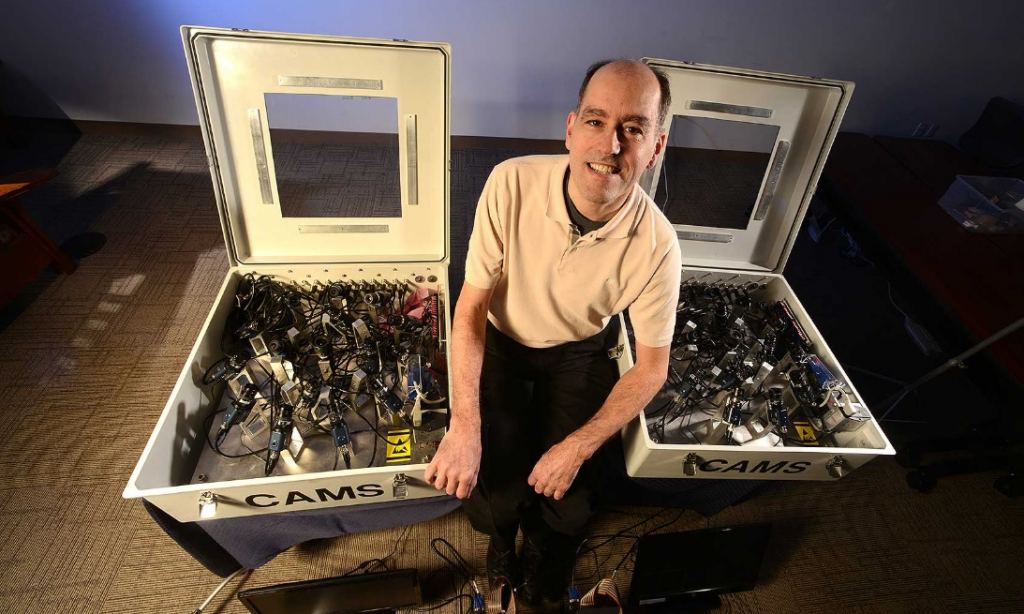
A typical CAMS all-sky meteor camera setup. Credit: SETI/NASA Ames/CAMS.
October is always an interesting month for meteors in general. In addition to a possible Arid outburst, the Taurid fireballs are active in early October, thanks to periodic comet 2P/Encke, holder of the shortest orbital period of any known comet at just 3.3 years. We’ve also got the peak for the elusive Draconids courtesy of Comet 21/P Giacobini-Zinner coming up on October 8th… though 2021 isn’t predicted to be an outburst year like 2011 and 2012. Finally, we have the Orionids on October 21st courtesy of 1P/Halley, though the Full Hunter’s Moon will interfere with the show.
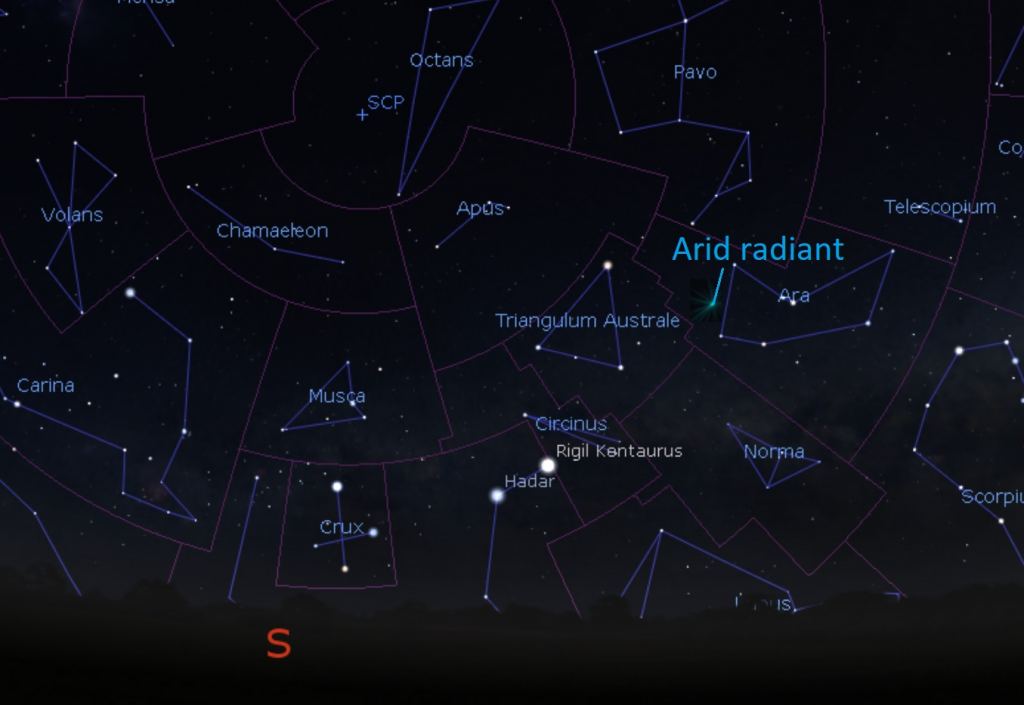
The Arid radiant near local midnight, as seen from near Santiago, Chile. Credit: Stellarium.
Keep an eye out for the Arids if you happen to be in the southern hemisphere this week… you may just catch the birth of a new meteor shower in the making.
Lead image: An early Arid meteor from late September. Credit: SETI/NASA Ames/CAMS.
This morning, I saw a bright artificial satellite that blinks repeatedly. It looks like it was seen with a wide-angle camera from his home in Hiratsuka toward the high sky east at 4:58 on October 5, 2021. When I checked the orbit, it was a Starlink satellite (STARLINK-2402 / NORAD 47819). It is believed to be spinning violently and may be out of control.
POSSIBLE ANTARCTIC METEOR OUTBURST:
The newly-discovered Arid meteor shower (described below) may have just produced an outburst over Antarctica. The University of Colorado Boulder operates a shortwave meteor radar at McMurdo Sound, and it detected a significant peak in meteor activity around 2300 UT on Oct. 6th. That matches the time Earth was expected to encounter a stream of debris from parent comet 15P/Finlay.
A NEW METEOR SHOWER: For thousands of years, Comet 15P/Finlay has been dive-bombing Earth's orbit, leaving trails of dust on our planet's doorstep, yet, strangely, there has never been a meteor shower. Until now. On Sept. 27th, Earth hit a stream of debris from Comet Finlay, and a meteor shower was born
SpaceWeather.com -- News and information about meteor showers, solar flares, auroras, and near-Earth asteroids
The newly-discovered Arid meteor shower (described below) may have just produced an outburst over Antarctica. The University of Colorado Boulder operates a shortwave meteor radar at McMurdo Sound, and it detected a significant peak in meteor activity around 2300 UT on Oct. 6th. That matches the time Earth was expected to encounter a stream of debris from parent comet 15P/Finlay.
A NEW METEOR SHOWER: For thousands of years, Comet 15P/Finlay has been dive-bombing Earth's orbit, leaving trails of dust on our planet's doorstep, yet, strangely, there has never been a meteor shower. Until now. On Sept. 27th, Earth hit a stream of debris from Comet Finlay, and a meteor shower was born
SpaceWeather.com -- News and information about meteor showers, solar flares, auroras, and near-Earth asteroids

Bright “Star” Next to Moon: What Planet Is Near the Moon Tonight?
What is that bright dot shining near the Moon tonight? Find out about stars and planets that can be seen next to our natural satellite this month!

Asteroids may be on way, each with more kinetic energy than an atomic bomb
Chinese researchers say hundreds of thousands of the space objects may be heading our way over the next century.
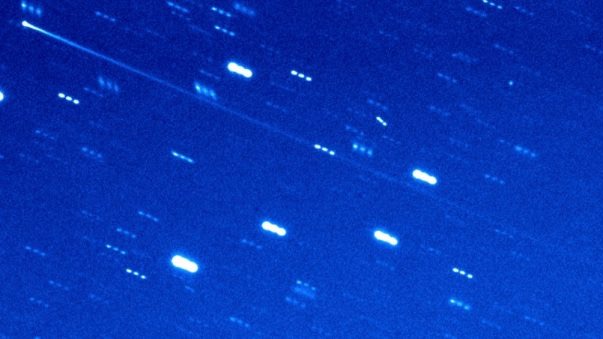
| EarthSky
Comet or asteroid? This object is both
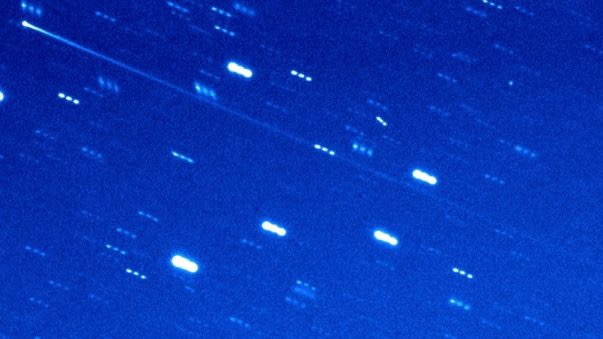
Comet or asteroid? The long streak in the upper left of in this image looks like a comet, but it lies in the asteroid belt. Palomar Observatory’s Hale Telescope in California took this composite image of the object – designated (248370) 2005 QN173 0 – on July 12, 2021. Stars in the field of view appear as short dotted lines. Image via Henry H. Hsieh (Planetary Science Institute)/ Jana Pittichová (NASA/JPL-Caltech).
Comet or asteroid?
If you saw an object in the asteroid belt with a long comet-like tail, what would you call it? A comet or an asteroid? Or perhaps a cometoid (meaning comet-like)? Scientists from the Planetary Science Institute announced on October 4, 2021, that a comet-like object in the asteroid belt that they’ve been studying is a rare type that transcends easy labeling. This object – designated (248370) 2005 QN173 – is the eighth active asteroid found, out of more than half a million known main-belt asteroids. Scientists are listing it as one of about 20 known main-belt comets.Lead author Henry Hsieh from the Planetary Science Institute presented this study at a press conference on October 4, at the 53rd annual meeting (in this case, a virtual meeting) of the American Astronomical Society’s Division for Planetary Sciences. The paper is accepted for publication in the peer-reviewed Astrophysical Journal Letters.
A main-belt comet
On July 7, 2021, the Asteroid Terrestrial-impact Last Alert System (ATLAS) survey witnessed activity on (248370) 2005 QN137. And this was not the only time the object was active. As Hsieh said:Main-belt comets are asteroids that present characteristics of comets. That is, they are icy and, when warmed by the sun, they release some of their material into space. The material then flows behind in comet-like tails. Hsieh explained:This behavior strongly indicates that its activity is due to the sublimation [process of changing from a solid to a gas] of icy material. As such, it’s considered a main-belt comet, and is one of just about 20 objects that have currently been confirmed or are suspected to be main-belt comets, including some that have only been observed to be active once so far.
[Object] 248370 can be thought of as both an asteroid and a comet, or more specifically, a main-belt asteroid that has just recently been recognized to also be a comet. It fits the physical definitions of a comet, in that it is likely icy and is ejecting dust into space, even though it also has the orbit of an asteroid. This duality and blurring of the boundary between what were previously thought to be two completely separate types of objects – asteroids and comets – is a key part of what makes these objects so interesting.
Analyzing (248370) 2005 QN137
The July 2021 observations revealed the nucleus, or head, of the main-belt comet enveloped in a dust cloud. The dust cloud is 2 miles (3.2 km) across. The tail was more than 450,000 miles (720,000 km) long. This is the same as the distance between the Earth and the moon times three. Yet the tail was rather skinny, at just 900 miles (1,400 km) wide. For comparison, if the comet (including its tail) were scaled to the length of a football field, the tail would be 7 inches wide and the nucleus would span half a millimeter across. Hsieh explained what these measurements mean:Hsieh continued:This extremely narrow tail tells us that dust particles are barely floating off of the nucleus at extremely slow speeds and that the flow of gas escaping from the comet that normally lifts dust off into space from a comet is extremely weak. Such slow speeds would normally make it difficult for dust to escape from the gravity of the nucleus itself, so this suggests that something else might be helping the dust to escape. For example, the nucleus might be spinning fast enough that it’s helping to fling dust off into space that has been partially lifted by escaping gas. Further observations will be needed to confirm the rotation speed of the nucleus though.
Cometary activity is generally thought to be caused by sublimation – the transformation from ice to gas – of icy material in a solar system object, which means that most comets are found to come from the cold outer solar system, beyond the orbit of Neptune, and spend most of their time there, with their highly elongated orbits only bringing them close to the sun and the Earth for short periods at a time. During those times when they are close enough to the sun, they heat up and release gas and dust as a result of ice sublimation, producing the fuzzy appearance and often spectacular tails associated with comets.
Comet or asteroid in the history of the solar system
Scientists believe that objects in the asteroid belt have been there since the formation of the solar system some 4.6 billion years ago. They further believed that any ice in these objects should have dissipated long ago. Yet these few rare objects, the main-belt comets, appear to defy these rules. Hsieh and David Jewitt discovered the first such creature in 2006.Main-belt comets are an interesting target of study, because scientists believe that much of Earth’s water came from asteroid impacts during the early years of the solar system’s formation. Finding objects in the asteroid belt that still contain ice provides a testing ground for learning more about the origin of life on Earth.
Bottom line: Comet or asteroid? How about both? Some objects in astronomy blur the lines between neat categorizations. The object (248370) 2005 QN173 is active with a long tail but resides in the asteroid belt.
A newly-discovered asteroid made a close approach to Earth on October 12, 2021.
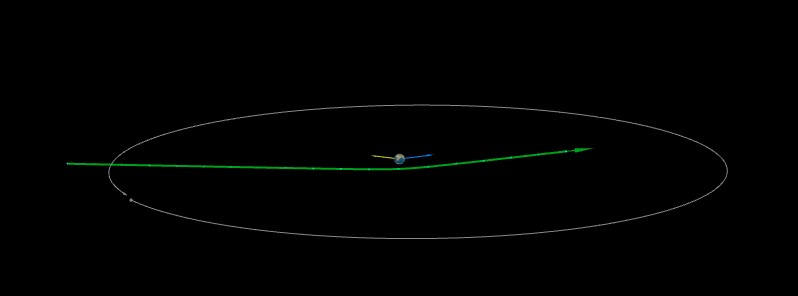
 watchers.news
Posted by Teo Blašković on October 14, 2021
watchers.news
Posted by Teo Blašković on October 14, 2021

 theskylive.com
theskylive.com
A bright fireball streaked through the night sky over the Valencia, Spain.
Published on Oct 14, 2021 (1:36)

Asteroid 2021 TE13 flew past Earth at 0.07 LD
A newly-discovered asteroid designated 2021 TE13 flew past Earth at a distance of 0.07 LD / 0.00018 AU (26 927 km / 16 732 miles) from the center of our planet at 09:53 UTC on October 12, 2021.

Asteroid (NEO) 2021 TE13 | TheSkyLive.com
Discover all the most important facts and information about Asteroid (NEO) 2021 TE13 updated in real time
A bright fireball streaked through the night sky over the Valencia, Spain.
Published on Oct 14, 2021 (1:36)
Bright fireball captured streaking in the sky above Leicester, UK.

 www.dailystar.co.uk
By Sofie Jackson - 16 OCT 2021
www.dailystar.co.uk
By Sofie Jackson - 16 OCT 2021

Dramatic moment fireball streaks across the sky above UK city
A meteor was caught on a car dashcam burning up in the Earth's atmosphere with its fiery tail streaking behind it, with viewers reckoning the fireball might be from the Draconids or Orionids meteor showers
#SPMN151021C ON THE CANARY ISLANDS, registered last night from Playa Blanca,#Lanzarote at 20h16m22s TU (21h16m Canary time) by Ramón López @StargazerLZT . If you saw it, leave us your reports for the list http://spmn.uji.es/ESP/reporte.html@AstroAficion
@GruposEstelares
Line-1
#SPMN161021C recorded yesterday at 5h20m39s TU from various stations. Here we have the detection of Jordi Donet @DonetJorge
from Barx-La Drova,#Valencia where the end is appreciated with its persistent green trail. Plus:http://spmn.uji.es/ESP/SPMNlist.h
Line-2
2) THAT BOLID LOOKED SO SPECTACULAR IN ITS BEGINNING from La Aparecida, Alicante / Alacant as recorded by Vicente Cayuelas @V_Cayuelas . It flew over the province of Castellón / Castelló at hypervelocity, specifically at about 194,000 km / h at its entrance into the atmosphere @V_Cayuelas . It flew over the province of Castellón / Castelló at hypervelocity, specifically at about 194,000 km / h at its entrance into the atmosphere
@GruposEstelares
Line-1
#SPMN161021C recorded yesterday at 5h20m39s TU from various stations. Here we have the detection of Jordi Donet @DonetJorge
from Barx-La Drova,#Valencia where the end is appreciated with its persistent green trail. Plus:http://spmn.uji.es/ESP/SPMNlist.h
Line-2
2) THAT BOLID LOOKED SO SPECTACULAR IN ITS BEGINNING from La Aparecida, Alicante / Alacant as recorded by Vicente Cayuelas @V_Cayuelas . It flew over the province of Castellón / Castelló at hypervelocity, specifically at about 194,000 km / h at its entrance into the atmosphere @V_Cayuelas . It flew over the province of Castellón / Castelló at hypervelocity, specifically at about 194,000 km / h at its entrance into the atmosphere
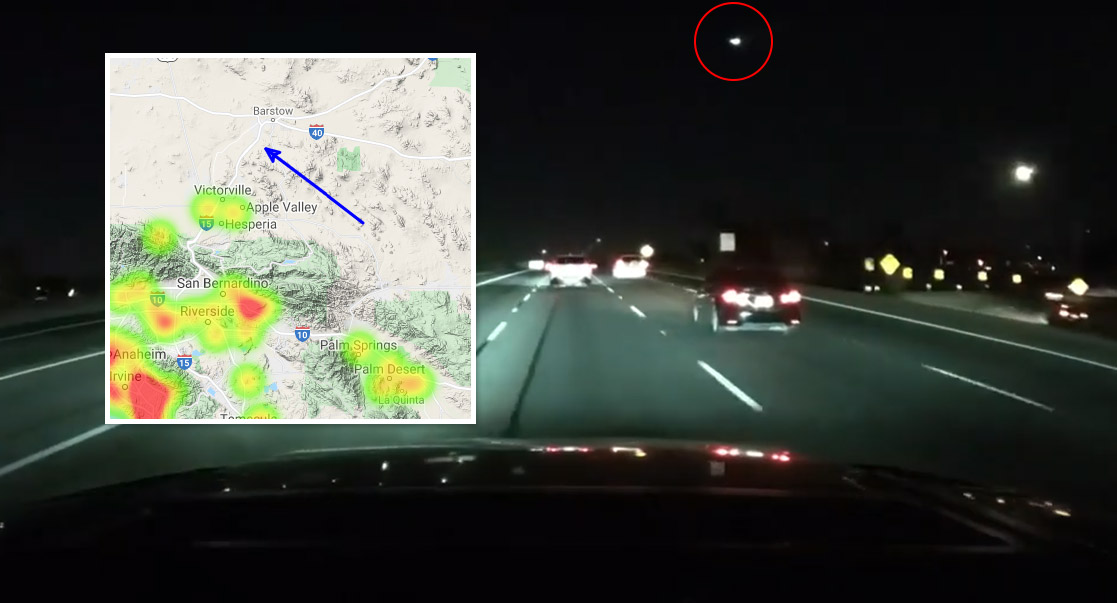
Fireball over SoCal on October 16th, 2021
The American Meteor Society received more than 115 reports so far about a fireball event that occurred over Southern California on October 16th just past 8:45 PM PDT (October 17th, 03:45 Universal Time). The AMS #2021-6638 event was mainly seen from California, but was also visible from...
More than 115 reports from 4 states
Ocean
The Living Force
From Mary Sutton Greeley.
Fireballs, meteorites. Hundreds of people called 911 to report sonic booms etc, in West Virginia.
I guess this just goes along with everything else strange that is happening. Grateful for honest pilots willing to report fireballs. I tend to trust pilots implicitly. This will undoubtedly show up on the Aviation sites.
Fireballs, meteorites. Hundreds of people called 911 to report sonic booms etc, in West Virginia.
I guess this just goes along with everything else strange that is happening. Grateful for honest pilots willing to report fireballs. I tend to trust pilots implicitly. This will undoubtedly show up on the Aviation sites.
Sonic Boom And Fireball Reported by 100's and Airline Pilots
Trending content
-
-
Thread 'Coronavirus Pandemic: Apocalypse Now! Or exaggerated scare story?'
- wanderingthomas
Replies: 30K -
